Related Research Articles
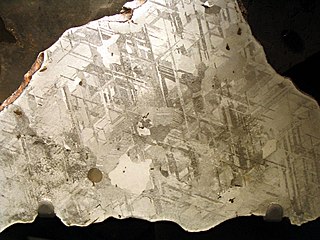
Kamacite is an alloy of iron and nickel, which is found on Earth only in meteorites. The proportion iron:nickel is between 90:10 and 95:5; small quantities of other elements, such as cobalt or carbon may also be present. The mineral has a metallic luster, is gray and has no clear cleavage although its crystal structure is isometric-hexoctahedral. Its density is about 8 g/cm3 and its hardness is 4 on the Mohs scale. It is also sometimes called balkeneisen.

Octahedrites are the most common structural class of iron meteorites. The structures occur because the meteoric iron has a certain nickel concentration that leads to the exsolution of kamacite out of taenite while cooling.

An iron meteorite fell on the Sikhote-Alin Mountains, in southeastern Russia, in 1947. Large iron meteorite falls have been witnessed and fragments recovered but never before, in recorded history, a fall of this magnitude. An estimated 23 tonnes of fragments survived the fiery passage through the atmosphere and reached the Earth.

Widmanstätten patterns, also known as Thomson structures, are figures of long nickel–iron crystals, found in the octahedrite iron meteorites and some pallasites. They consist of a fine interleaving of kamacite and taenite bands or ribbons called lamellae. Commonly, in gaps between the lamellae, a fine-grained mixture of kamacite and taenite called plessite can be found. Widmanstätten patterns describe features in modern steels, titanium, and zirconium alloys.

The Canyon Diablo meteorite refers to the many fragments of the asteroid that created Meteor Crater, Arizona, United States. Meteorites have been found around the crater rim, and are named for nearby Canyon Diablo, which lies about three to four miles west of the crater.

Meteoric iron, sometimes meteoritic iron, is a native metal and early-universe protoplanetary-disk remnant found in meteorites and made from the elements iron and nickel, mainly in the form of the mineral phases kamacite and taenite. Meteoric iron makes up the bulk of iron meteorites but is also found in other meteorites. Apart from minor amounts of telluric iron, meteoric iron is the only naturally occurring native metal of the element iron on the Earth's surface.
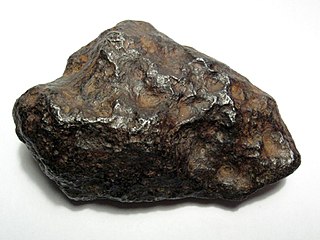
Ataxites are a structural class of iron meteorites with a high nickel content and show no Widmanstätten patterns upon etching.

Taenite is a mineral found naturally on Earth mostly in iron meteorites. It is an alloy of iron and nickel, with a chemical formula of Fe,Ni and nickel proportions of 20% up to 65%.

Iron meteorites, also known as siderites, or ferrous meteorites, are a type of meteorite that consist overwhelmingly of an iron–nickel alloy known as meteoric iron that usually consists of two mineral phases: kamacite and taenite. Most iron meteorites originate from cores of planetesimals, with the exception of the IIE iron meteorite group

The Fukang meteorite is a meteorite that was found in the mountains near Fukang, China in 2000. It is a pallasite—a type of stony–iron meteorite with olivine crystals. It is estimated to be 4.5 billion years old.
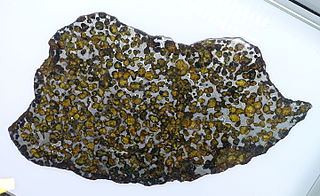
The Springwater meteorite is a stony-iron pallasite, found near Springwater, Saskatchewan in 1931. At that time the find consisted of three large masses (38.6 kilograms, 18.6 kilograms and 10.6 kilograms. Other fragments have been found recently, including a 53 kilograms individual in 2009 that is now in the Royal Ontario Museum.

The Chinga meteorite is an iron meteorite. It is structurally an ataxite with very rare kamacite lamella. The meteoric iron is a part of the lamella taenite. The total chemical composition is 82.8% iron, 16.6% nickel, and the rest mostly cobalt and phosphorus.
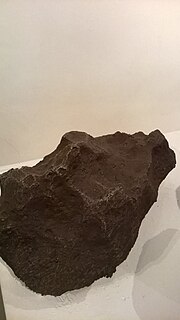
The Dronino meteorite is a 40-kilogram (88 lb) iron meteorite that was found in the Ryazan Oblast of Russia in July 2000. It is classified as an ataxite.

IAB meteorites are a group of iron meteorites according to their overall composition and a group of primitive achondrites because of silicate inclusions that show a strong affinity to winonaites and chondrites.

IVB meteorites are a group of ataxite iron meteorites classified as achondrites. The IVB group has the most extreme chemical compositions of all iron meteorites, meaning that examples of the group are depleted in volatile elements and enriched in refractory elements compared to other iron meteorites.
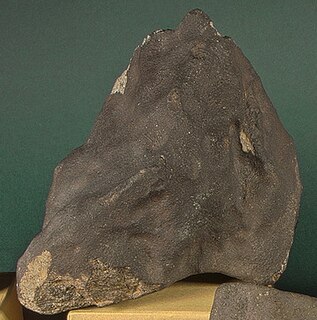
The Tamdakht meteorite fell near Ouarzazate, Morocco on 20 December 2008 producing a strewn field of approximately 25 kilometres (16 mi) by 2 kilometres (1.2 mi) and two small impact craters, one of about 1.1 metres diameter and 70 centimetres (28 in) depth at 31°09.8′N7°00.9′W and the other of about 20 centimetres (7.9 in) diameter and 10 centimetres (3.9 in) depth at 31°09.9′N07°02.3′W.
The Santa Vitoria do Palmar meteorite was found near the city of Santa Vitoria do Palmar in Brazil in 2003 and 2004.
This is a glossary of terms used in meteoritics, the science of meteorites.

IIAB meteorites are a group of iron meteorites. Their structural classification ranges from hexahedrites to octahedrites. IIABs have the lowest concentration of nickel of all iron meteorite groups. Most iron meteorites are derived from the metallic planetary cores of their respective parent bodies, but in the case of the IIABs the metallic magma separated to form not only this meteorite group but also the IIG group.
Chukanovite is an iron(II) hydroxide-carbonate mineral with the ideal chemical formula Fe+22(CO3)(OH)2. It is a member of the rosasite mineral group and crystalizes in the monoclinic crystal system. Upon initial crystallization, it is typically pale green to colorless, but it takes on a brownish green hue after being altered at the surface. As a weathering product of meteoritic iron, chukanovite is a relatively uncommon mineral on Earth, having only been discovered in the year 2000. However, it is commonly formed artificially as a corrosion byproduct through the manufacturing of sand-deposited carbon steel.
References
- 1 2 3 Meteoritical Bulletin Database
- ↑ Kissin,S. A.; Herd, R. K., 1995, Two New Iron Meteorites from the Province of Quebec, Canada, Meteoritics, vol. 30,no. 5, page 527